Coupled Coordination Analysis and Driving Factors of “Water-Carbon-Ecology” System in the Yangtze River Economic Belt
Abstract
:1. Introduction
2. Materials and Methods
2.1. Research Framework
2.2. Multidimensional Evaluation Model
2.2.1. Construction of Evaluation Index System
2.2.2. Determining Indicator Weights
2.2.3. W-C-E System Coupling Coordinated Development Index
2.3. Analysis of Driving Factors
2.3.1. Obstacle Degree Model
2.3.2. Geographic Detector Model
3. Results and Discussion
3.1. W-C-E Multidimensional Coupled Coordination System Analysis
3.1.1. Richness of a Single System
3.1.2. Coordination Between Two Systems
3.1.3. The Third System Robustness
3.1.4. Analysis of Spatiotemporal Variation Trend of WCENI
3.2. Analysis of Driving Factors of W-C-E System
3.2.1. Analysis of Obstacle Factors in W-C-E System
3.2.2. W-C-E System of the Single Factor Detection Analysis
3.2.3. Analysis of the Interaction Between Two Factors of W-C-E System
4. Conclusions and Policy Proposals
4.1. Conclusions
4.2. Policy Proposals
Author Contributions
Funding
Institutional Review Board Statement
Informed Consent Statement
Data Availability Statement
Conflicts of Interest
References
- Zhang, C.; Zhao, L.; Song, X.; Zhang, Q.; Zhang, X. Spatial-temporal coupling characteristics and interaction effects of economic resilience and people’s livelihoods and well-being: An analysis of 78 cities in the Yellow River Basin. Sustain. Cities Soc. 2024, 112, 105638. [Google Scholar] [CrossRef]
- Zhang, Y.; Yang, Y. Can the resource and environmental dilemma due to water-energy-carbon constraints be solved in the process of new urbanization. Sustain. Cities Soc. 2024, 114, 105748. [Google Scholar] [CrossRef]
- Yan, X.; Chen, J.; Zhou, S. Carbon metabolism mechanisms and evolution characteristics analysis of the food-water-energy nexus system under blue-green infrastructure changes. Sci. Total Environ. 2024, 951, 175763. [Google Scholar] [CrossRef] [PubMed]
- Martínez-Ibáñez, E.; Laso, J.; Vázquez-Rowe, I.; Ceballos-Santos, S.; Fernández-Rios, A.; Margallo, M.; Aldaco, R. Integrating the water-energy-food nexus and LCA + DEA methodology for sustainable fisheries management: A case study of Cantabrian fishing fleets. Sci. Total Environ. 2024, 949, 175223. [Google Scholar] [CrossRef] [PubMed]
- Yu, L.; Peng, K.; Huang, Y.; Chen, F.; Chen, S.; Xia, Y.; Huang, X.; Ni, X.; Guo, R.; Cai, C.; et al. Application of a water-energy-carbon coupling index to evaluate the long-term operational stability of the anaerobic-anoxic-oxic-membrane bioreactor (A2/O-MBR) process under the influence of rainstorms. Water Res. 2024, 255, 121489. [Google Scholar] [CrossRef] [PubMed]
- Feng, Y.; Wang, J.; Ren, X.; Zhu, A.; Xia, K.; Zhang, H.; Wang, H. Impact of water utilization changes on the water-land-energy-carbon nexus in watersheds: A case study of Yellow River Basin, China. J. Clean. Prod. 2024, 443, 141148. [Google Scholar] [CrossRef]
- Wang, M.; Zhong, X.; Yuan, H.; Zhang, D.; Cheng, L.; Zhang, J. Integrating carbon and water footprint into nature-based solution (NBS) for urban planning in a highly built-up area in Guangzhou, China. Sci. Total Environ. 2024, 951, 175505. [Google Scholar] [CrossRef] [PubMed]
- Li, J.; Zhao, M.; Han, Y.; Wei, J. Assessment on water cycle health in the Central Plains Urban cluster based on the DSWU NWU SWS NWS A—WCHI model. Ecol. Indic. 2023, 157, 111236. [Google Scholar] [CrossRef]
- Chen, L.; Li, X.; Kang, X.; Liu, W.; Wang, M. Analysis of the cooperative development of multiple systems for urban Economy-Energy-Carbon: A case study of Chengdu-Chongqing Economic Circle. Sustain. Cities Soc. 2024, 108, 105395. [Google Scholar] [CrossRef]
- Jin, K.; Zhang, S.; Yang, Y.; Chen, X.; Wang, S.; Li, T.; Wang, Y. Evaluation of water-carbon-ecological footprints and its spatial–temporal pattern in the central plains urban agglomeration. Ecol. Indic. 2023, 155, 110982. [Google Scholar] [CrossRef]
- Pang, B.; Li, X.; Fu, Y. Coupling coordination analysis and obstacle factors of water-energy-environment-economy in the Yellow River Basin. J. Clean. Prod. 2024, 468, 143108. [Google Scholar] [CrossRef]
- Jing, P.; Sheng, J.; Hu, T.; Mahmoud, A.; Guo, L.; Liu, Y.; Wu, Y. Spatiotemporal evolution of sustainable utilization of water resources in the Yangtze River Economic Belt based on an integrated water ecological footprint model. J. Clean. Prod. 2022, 358, 132035. [Google Scholar] [CrossRef]
- Zhang, Y.; Cui, J.; Liu, X.; Liu, H.; Liu, Y.; Jiang, X.; Li, Z.; Zhang, M. Application of water-energy-food nexus approach for optimal tillage and irrigation management in intensive wheat-maize double cropping system. J. Clean. Prod. 2022, 381, 135181. [Google Scholar] [CrossRef]
- Zhang, K.; Jin, Y.; Li, D.; Wang, S.; Liu, W. Spatiotemporal variation and evolutionary analysis of the coupling coordination between urban social-economic development and ecological environments in the Yangtze River Delta cities. Sustain. Cities Soc. 2024, 111, 105561. [Google Scholar] [CrossRef]
- Zheng, C.; Yang, W.; Jiang, X.; Lian, J.; Hu, D.; Yan, X.; Yan, L. A novel integrated Urban flood risk assessment approach coupling GeoDetector-Dematel and clustering method. J. Environ. Manag. 2024, 354, 120308. [Google Scholar] [CrossRef] [PubMed]
- Zhu, J.; Yin, D.; Li, X.; Zhu, R.; Zheng, H. Divergent determinants on interannual variability of terrestrial water cycle across the globe. Sci. Total Environ. 2024, 945, 174046. [Google Scholar] [CrossRef] [PubMed]

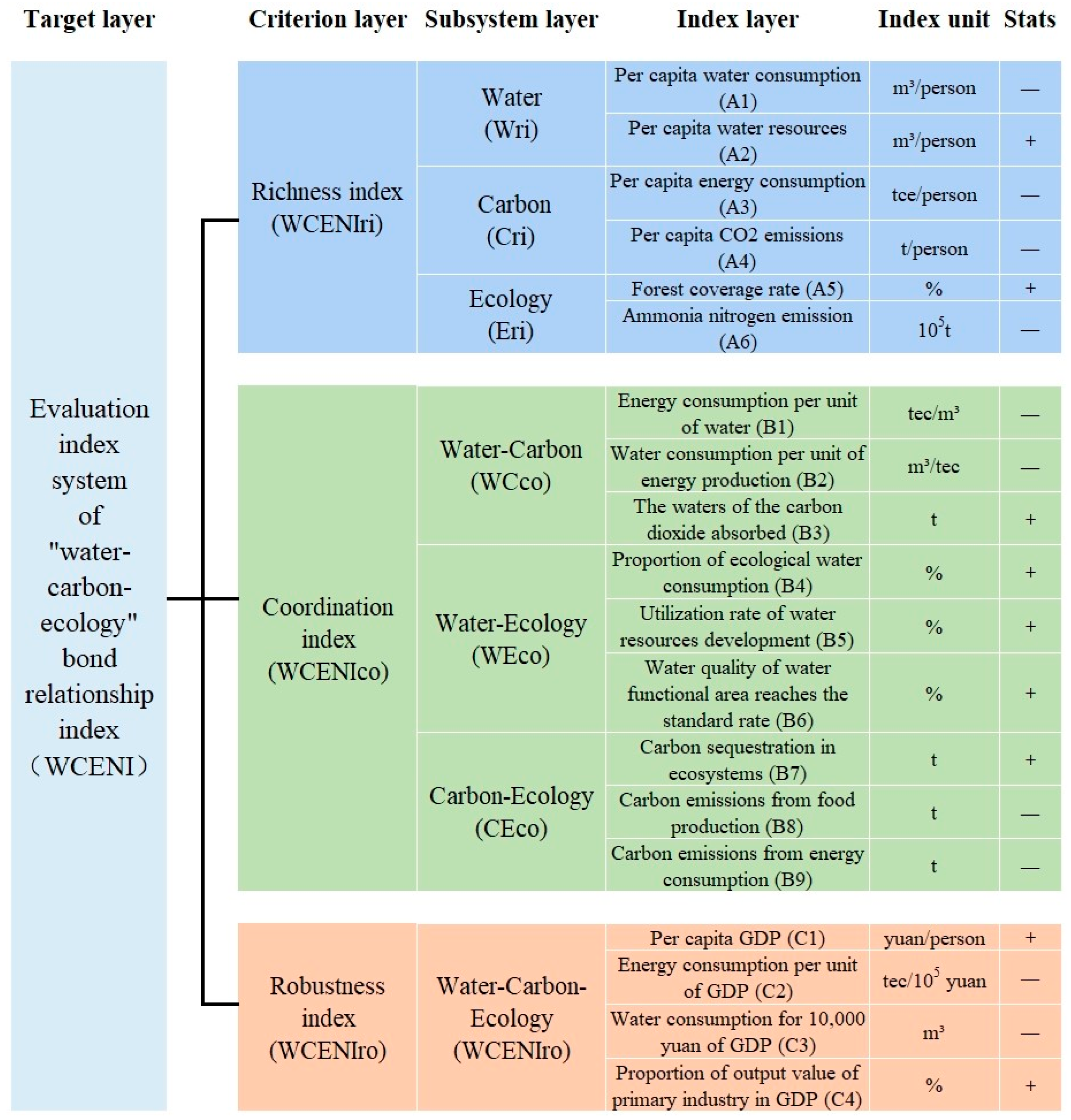
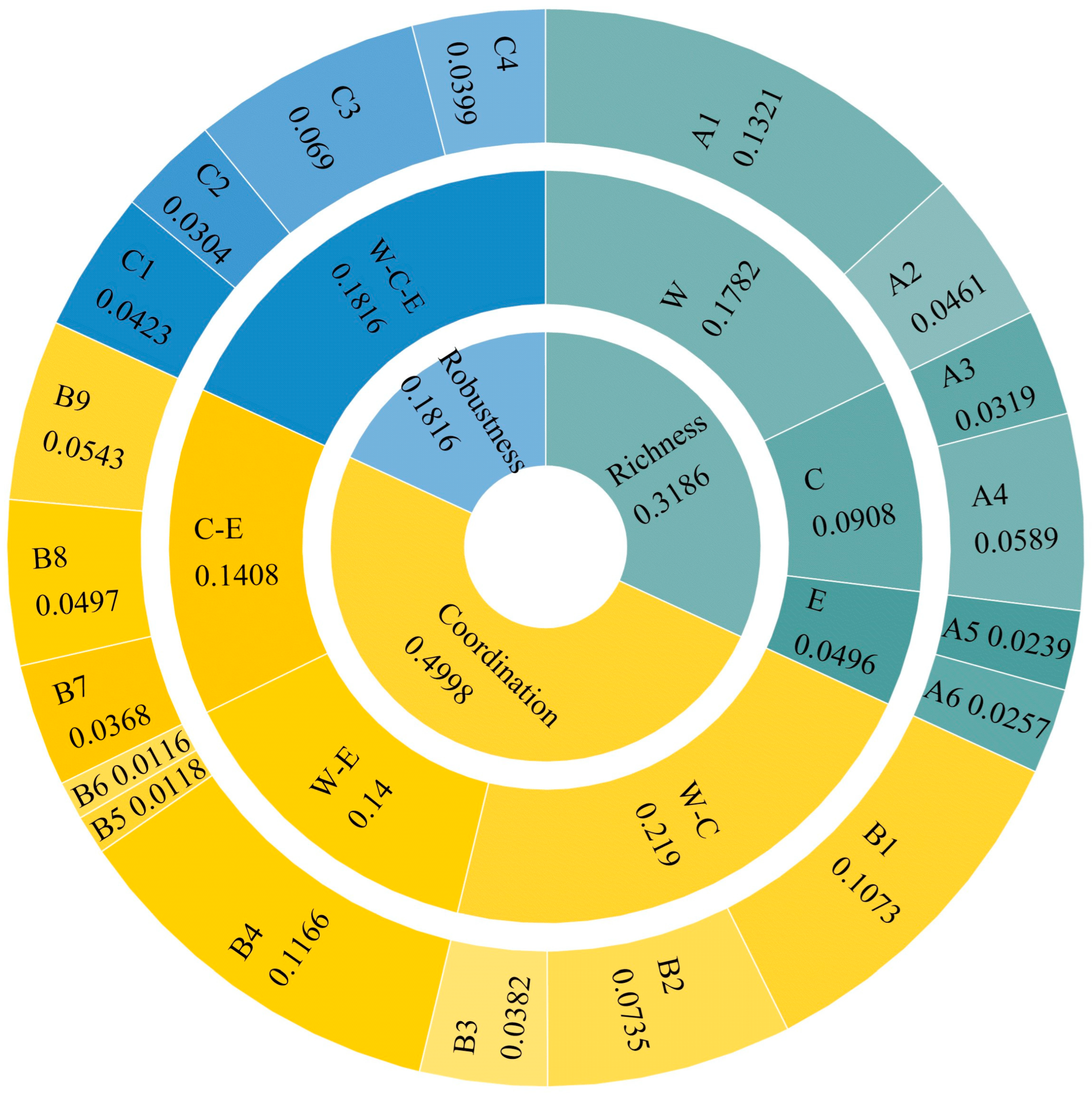


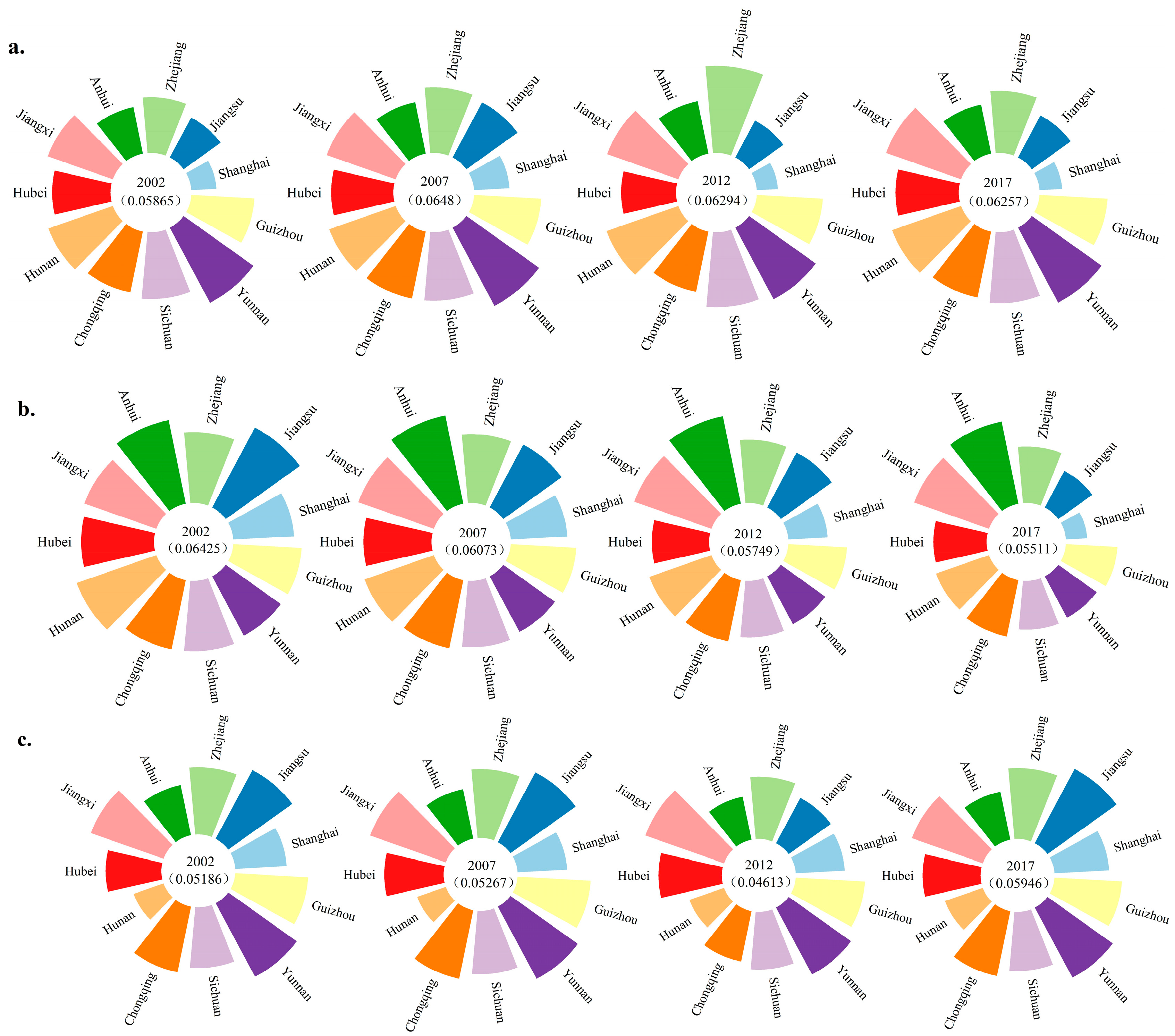

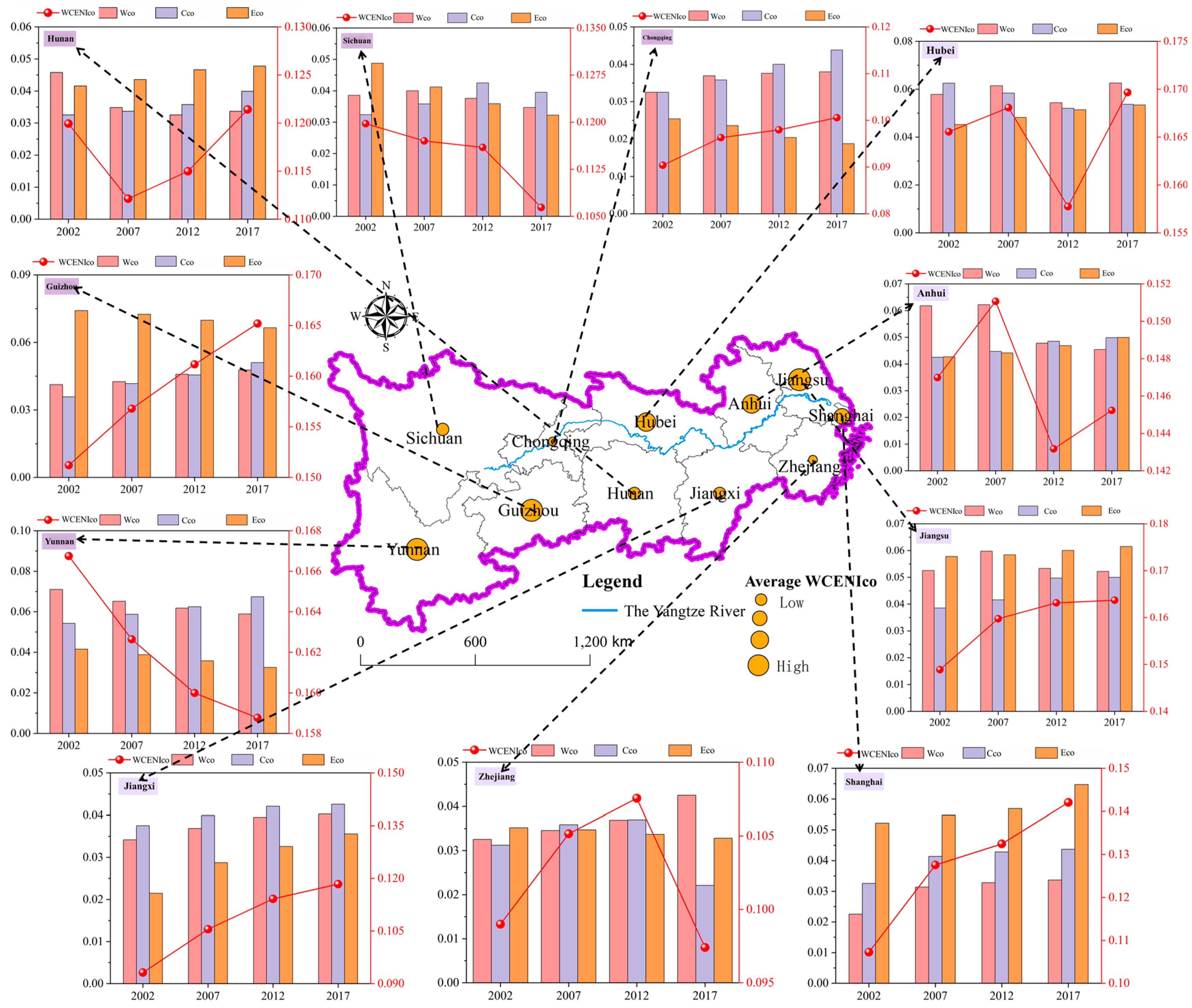


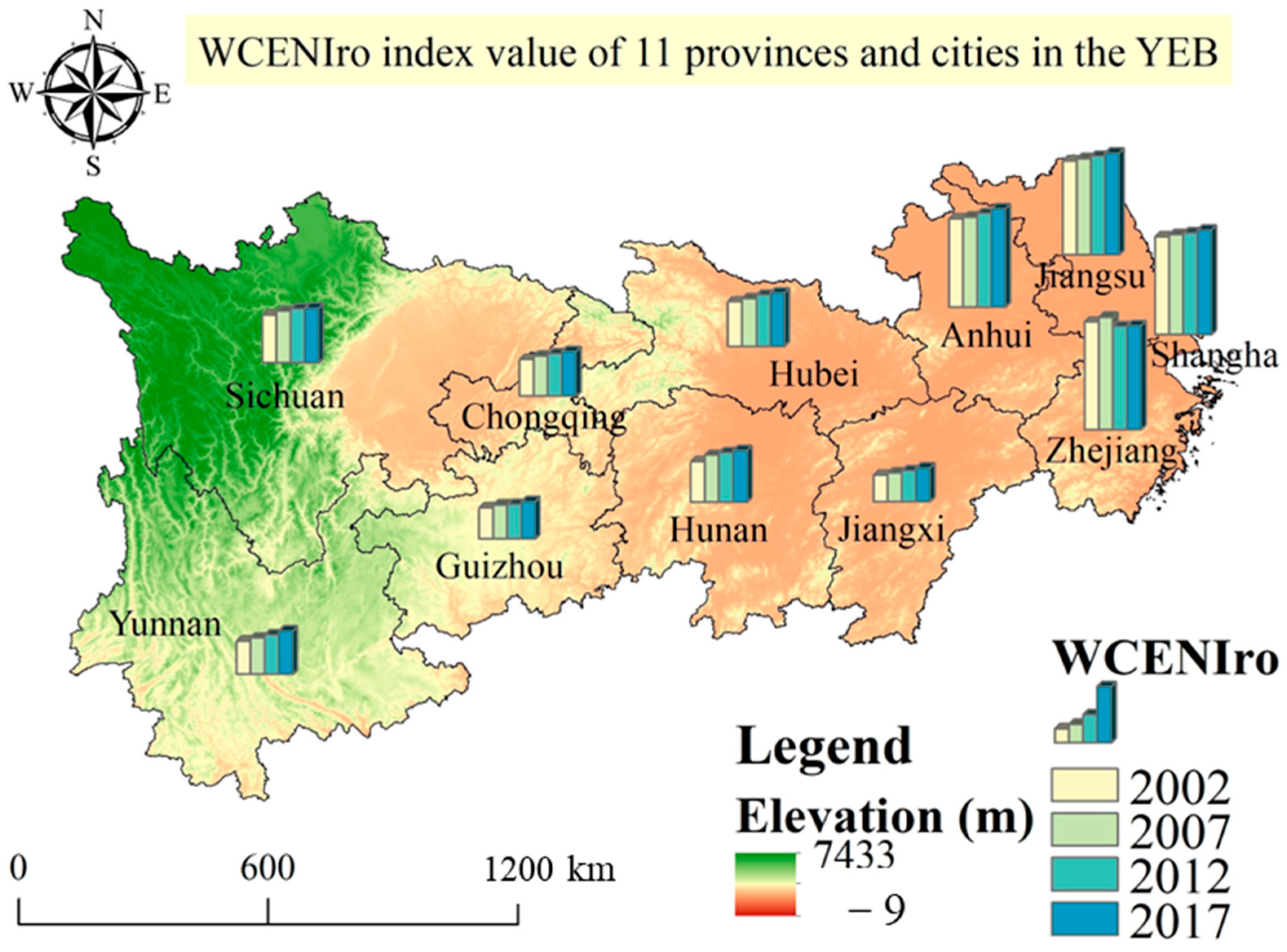
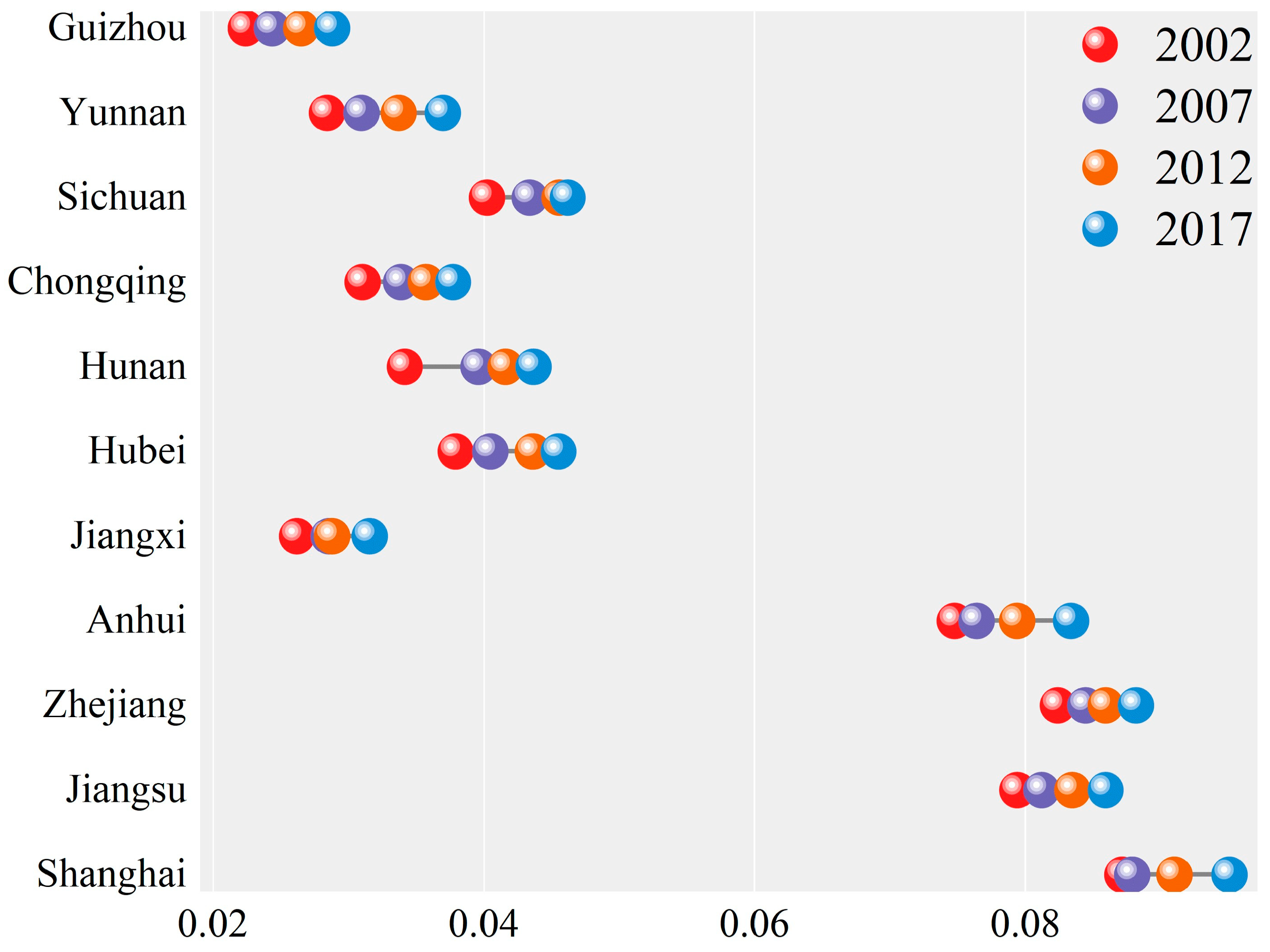
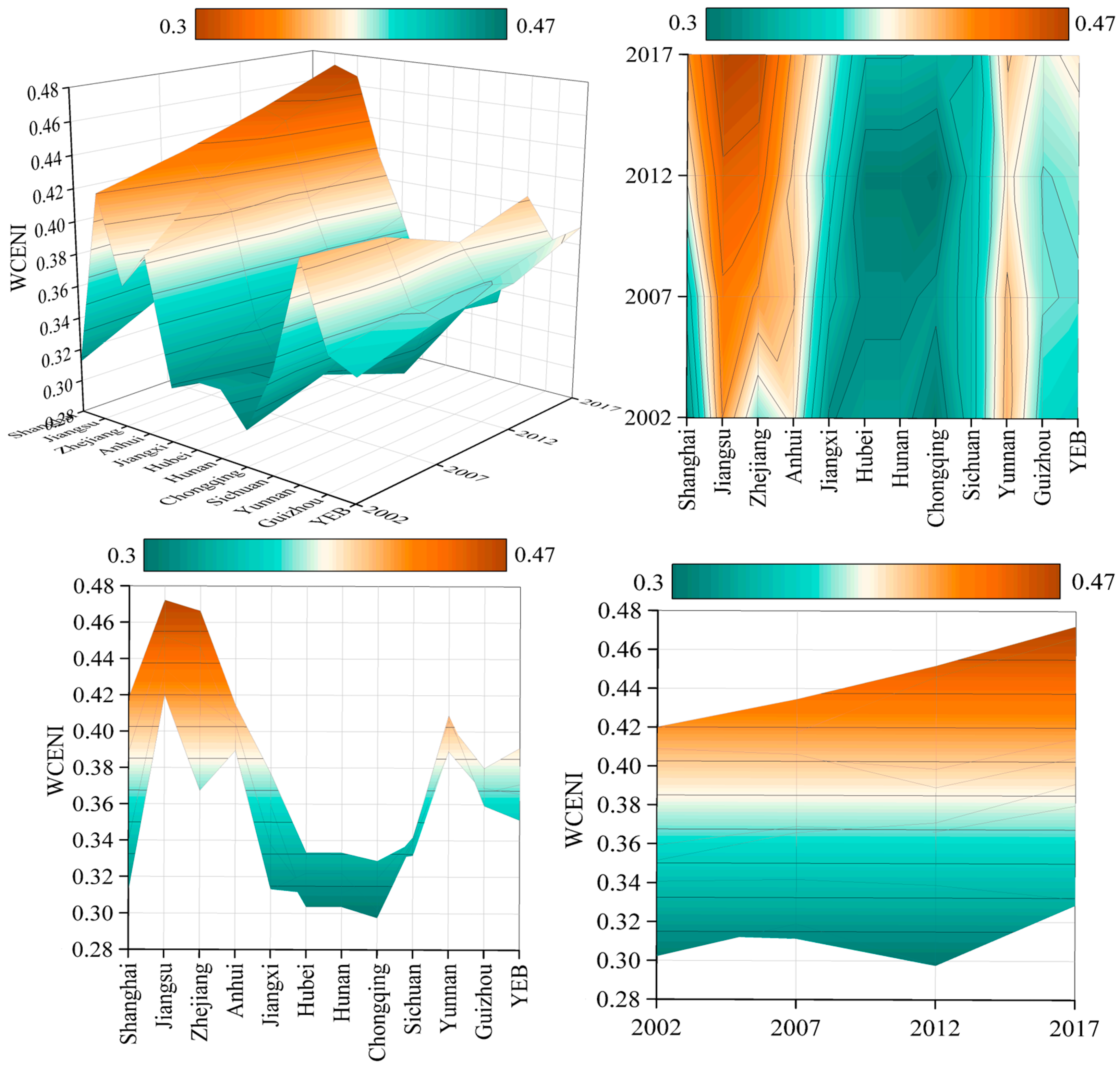



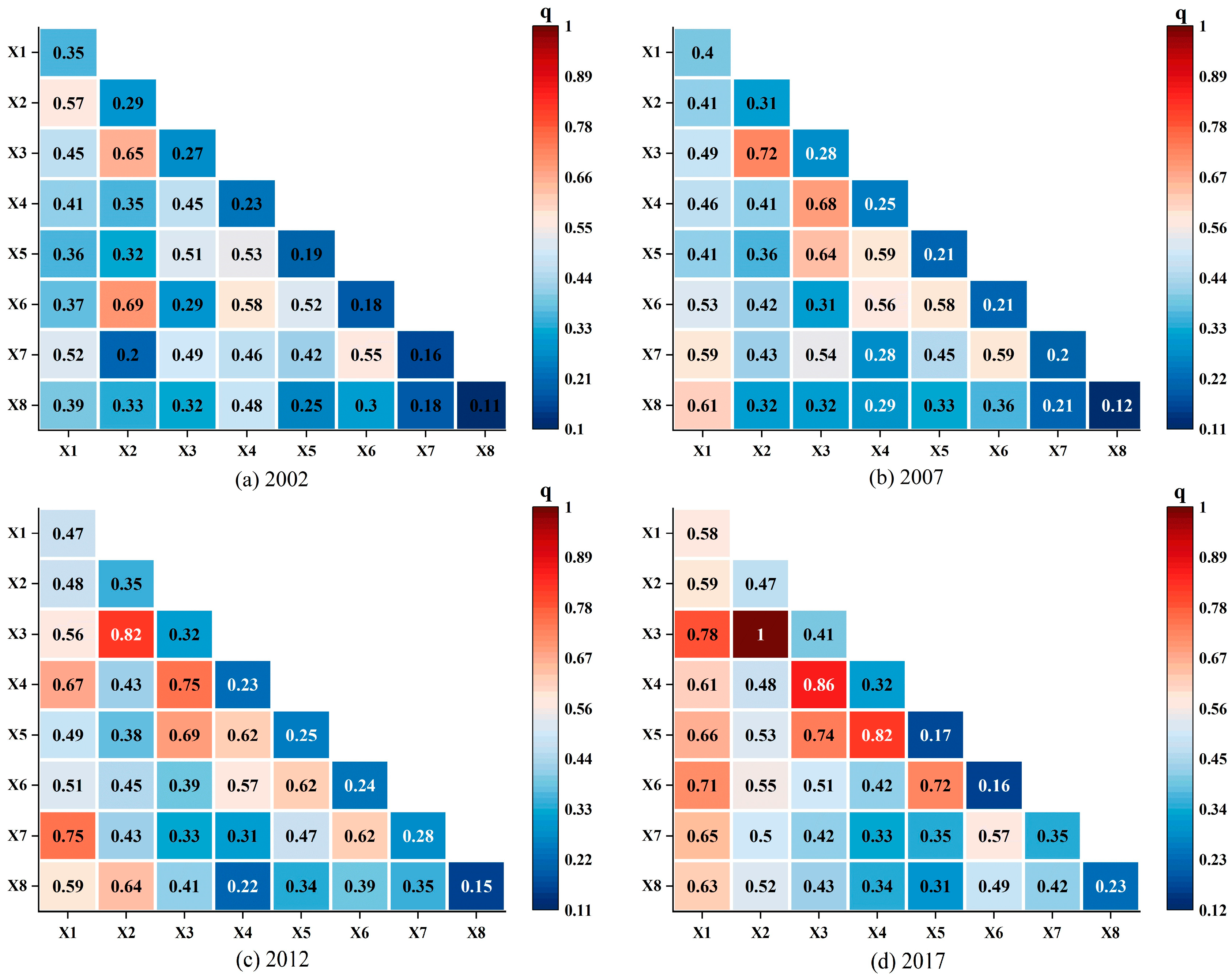
| Variable Type | Variable Dimension | Variable Index | Variable Symbol |
|---|---|---|---|
| Dependent variable | Coupling coordination degree | WCENI | Y |
| Independent variable | Urbanization level | Built-up area | X1 |
| Technological development level | Proportion of research and experimental funding | X2 | |
| Government regulation ability | Proportion of provincial investment in environmental pollution control in GDP | X3 | |
| Residents’ living standard | The proportion of social retail goods in GDP | X4 | |
| Degree of opening up | Total value of imports and exports of goods as a proportion of GDP | X5 | |
| Labor force factor | Proportion of employment in the tertiary industry | X6 | |
| Degree of population growth | Natural rate of population growth | X7 | |
| Educational level | Educational expenditure | X8 |
Disclaimer/Publisher’s Note: The statements, opinions and data contained in all publications are solely those of the individual author(s) and contributor(s) and not of MDPI and/or the editor(s). MDPI and/or the editor(s) disclaim responsibility for any injury to people or property resulting from any ideas, methods, instructions or products referred to in the content. |
© 2025 by the authors. Licensee MDPI, Basel, Switzerland. This article is an open access article distributed under the terms and conditions of the Creative Commons Attribution (CC BY) license (https://creativecommons.org/licenses/by/4.0/).
Share and Cite
Li, J.; Han, Y.; Zhao, M.; Cao, R.; Jiang, Z. Coupled Coordination Analysis and Driving Factors of “Water-Carbon-Ecology” System in the Yangtze River Economic Belt. Sustainability 2025, 17, 3566. https://doi.org/10.3390/su17083566
Li J, Han Y, Zhao M, Cao R, Jiang Z. Coupled Coordination Analysis and Driving Factors of “Water-Carbon-Ecology” System in the Yangtze River Economic Belt. Sustainability. 2025; 17(8):3566. https://doi.org/10.3390/su17083566
Chicago/Turabian StyleLi, Jinhang, Yuping Han, Mengdie Zhao, Runxiang Cao, and Zhuo Jiang. 2025. "Coupled Coordination Analysis and Driving Factors of “Water-Carbon-Ecology” System in the Yangtze River Economic Belt" Sustainability 17, no. 8: 3566. https://doi.org/10.3390/su17083566
APA StyleLi, J., Han, Y., Zhao, M., Cao, R., & Jiang, Z. (2025). Coupled Coordination Analysis and Driving Factors of “Water-Carbon-Ecology” System in the Yangtze River Economic Belt. Sustainability, 17(8), 3566. https://doi.org/10.3390/su17083566





